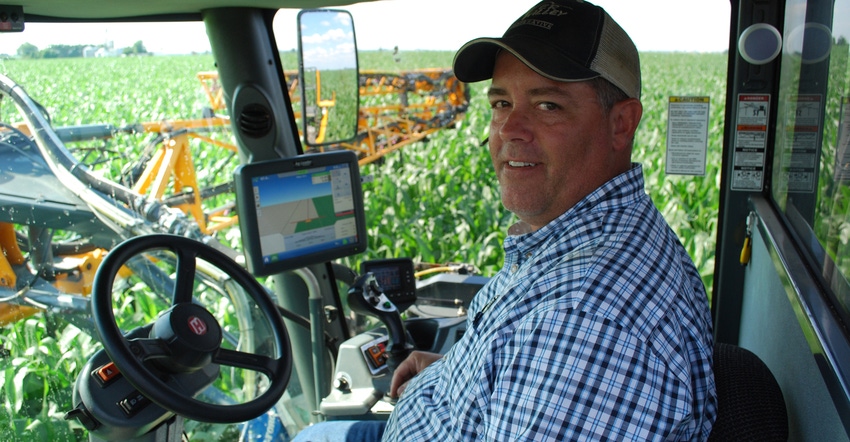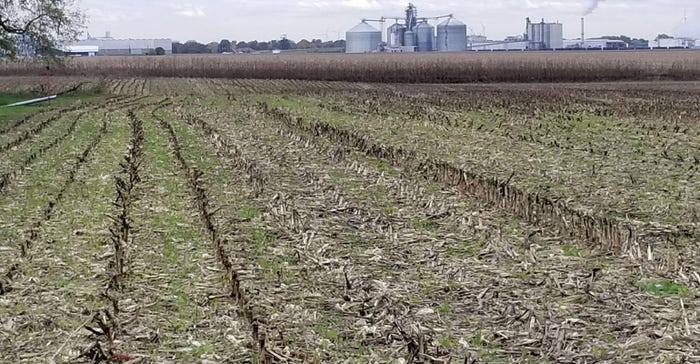
After six years, Dwight cover cropper and farmer Matt Boucher expects the disbelieving looks from farmers while he plants soybeans into 5-foot-tall cover crops. “We’ve been planting cover crops for years now, and while others have expressed concern, we’ve found success,” he says. “We’re sold on it.”
Boucher wasn’t as confident the first time he planted into a tall cover crop. “It made me unbelievably and totally nervous the first time we did it on 11.5 acres along the main road,” he adds. “I had everyone’s attention, but it worked out great.”
The takeaway? It takes time to get comfortable with cover crops and integrate them into your operation, says six-year cover crop veteran Brian Corkill — and perhaps even more time to reap the benefits. Corkill, who farms near Galva recently signed up with the Soil Health Partnership to help quantify the cover crop benefits he’s seen on his farm. “I know I don’t want to go away from cover crops, but I can’t tell you to the penny what the benefit is,” he explains, adding that all of his fields have cover crops for the 2018 season.
Viola farmer Chad Bell is finding different ways to measure cover crop success. Now in his fifth year working with cover crops, he is part of the Growmark 4R4U N-Watch trial, which compares his no-till fields with and without cover crops, split rates of nitrogen on no-till fields with and without cover crops, and nitrogen availability throughout the season. Trial results are pending, but Bell’s cover crops help control soil erosion, build healthier top soils and push yields higher than he’s seen before on his farm.
But there have been bumps along the way for all three farmers.
What have they learned about cover crops over the past few years? Prairie Farmer asked Boucher, Corkill and Bell to share what works and what doesn’t work on their farms. First up: Brian Corkill.
Brian Corkill: cover crop believer
After 20 years of farming, Corkill was ready to change things up; he began experimenting with cover crops six years ago on his Galva farm.
A new passion was born.
“We’re starting to learn more about how soil works, and now we have the tools to improve it,” he says. “We need to put back what previous generations have taken away.”
Corkill learns something new every day about soil biology, soil regeneration and what each cover crop species may bring to the farm. His 100-acre cover crop trial started with a simple goal: Reduce soil erosion and compaction. This year, all of his acres will have cover crops.
“I’m moving to a point where I’m looking at sequestered nutrients and soil biology,” he says. His plan starts with a tailored mix of cover crop species to attract the right combination of microorganisms that break down residue and release nutrients into the growing crop.
Establishing a cover crop
Corkill took annual ryegrass off his cover crop list early on. “We just couldn’t get it to grow,” he says. Hardy cover crops like cereal rye and winter barley can handle colder conditions, and they are easier to terminate, so Corkill uses an air seeder on a vertical-tillage tool to plant 60 pounds per acre of cereal rye and winter barley on 60% of his acres. In September, a helicopter aerially seeded 33 pounds per acre of cereal rye, winter barley, black oats, tillage radish, turnip and rapeseed into his standing crop.
“What we seed with our vertical-tillage tool works better, but we’ve had good luck with both,” he notes. “You don’t get great establishment with aerial seeding; you get good establishment.” Corkill has found that helicopters provide a more consistent stand than planes, by flying lower and covering field corners better.
 CUSTOM BLEND: Brian Corkill aerial-applied 33 pounds per acre of cereal rye, winter barley, black oats, tillage radish, turnip and rapeseed into his standing crop.
CUSTOM BLEND: Brian Corkill aerial-applied 33 pounds per acre of cereal rye, winter barley, black oats, tillage radish, turnip and rapeseed into his standing crop.

Why not plant everything with the vertical-tillage tool?
“There’s some give and take on stand establishment versus being able to seed a more diverse cover crop,” he says. “That’s the issue we run into here further north. If you wait until after harvest to do turnips and rapeseed, you just don’t have enough season left to get much out of it. I know I won’t get perfect establishment from flying them on, but I’ll get the benefit of cover crop diversity.”
What about price? Corkill’s aerial-seeded mix is roughly $37 per acre, including helicopter fees, and air-seeding the cereal rye and barley mix costs about $22 per acre.
Tackling termination
Mother Nature encouraged Corkill to change his approach to cover crop termination.
In 2016, he planned to plant into an established cover crop on 20 acres. “I talked to enough cover crop guys to get comfortable doing it on a small scale, just to get my feet wet,” Corkill says. Several rain events prevented termination until the cereal rye was 6 to 7 feet tall across all of his soybean acres. Instead of a trial run, he planted into standing cover crops terminated with 32 to 36 ounces of Roundup PowerMax and a residual herbicide one day ahead of planting, or within seven days of planting. “We got along really good, so we were comfortable doing it again this year,” he adds.
Weed suppression is a welcomed side effect from letting the cover crop grow until planting, Corkill says, especially with small-seeded broadleaves like waterhemp.
Nutrient efficiency is another benefit. “In one of our longest-running cover crop fields, we ended up with an average of 0.58 pound of nitrogen per bushel, and the field yielded 250 bushels an acre,” he says. “That tells me that we’re sequestering nutrients, and as long as we try to have something growing any time of the year something can grow, that will help us be more efficient with our fertilizer.”
Corkill hasn’t cut back on nitrogen applications, but his yields are higher with the same amount of fertilizer.
One step further
Weed suppression. Nutrient efficiency. Those are two good reasons to stick with cover crops, but Corkill wants numbers. What’s the return on investment? “I want to quantify what I think we know,” he explains, and adds the Soil Health Partnership will pull extensive soil tests each year to track soil health over time. Next spring, Corkill will pull soil tests on all his fields. “I’m really curious to see organic matter,” he says, adding his last samples were pulled in 2014.
What’s another measurement angle? A cover crop nutrient report.
In spring 2017, Corkill pulled growing cover crop matter from a 24-by-24-inch section and sent it to a lab for an analysis.
“We had 275 pounds of nitrogen sequestered per acre and 402 pounds of potassium,” he notes. “That got me excited. I realize that all of that won’t be available in the same year, but those are nutrients we haven’t lost to groundwater, and they didn’t end up in the Gulf of Mexico. I had no idea that was the power of growing a cover crop.”
Editor’s note: Check back in the coming days for more cover crop experiences from Illinois farmers.
About the Author(s)
You May Also Like




